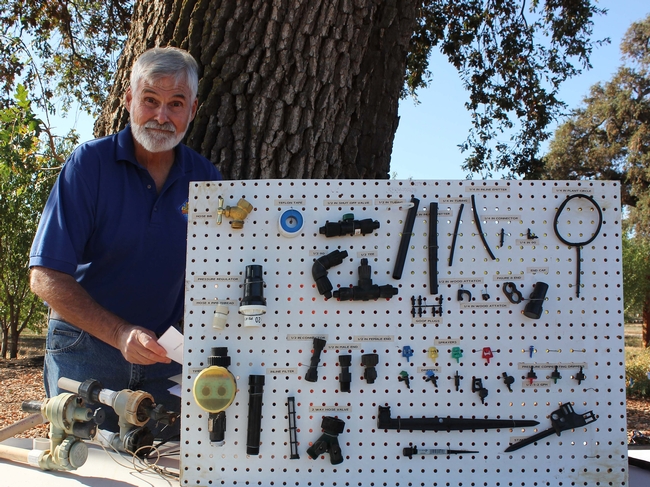By Brent McGhie, UC Master Gardener of Butte County, May 19, 2017.

The most important advantage to drip irrigation is that it is more efficient than traditional irrigation methods. Drip emitters can be placed to deliver water only where it is needed, so water isn't wasted on unplanted areas. By applying water slowly, drip irrigation also allows water to be absorbed quickly into the soil instead of standing on the soil surface. This means that far less water is lost to evaporation than with flood irrigation or sprinklers. Additionally, because water sinks into the soil rather than puddling, there is less loss due to runoff, which makes drip irrigation a good choice for steep terrain. Another way in which drip systems can conserve water is by installing them under a layer of mulch, promoting even greater water savings by further reducing evaporation from the soil. Last but not least, it should be noted that by saving water, drip irrigation also saves the homeowner money.
Drip irrigation has several other advantages. In addition to water, plant roots also need air and when soil pores are completely flooded, roots can actually “suffocate.” The slow application of water by drip systems virtually guarantees a good soil/water environment with a balance of water and oxygen in the soil. Next, weeds don't grow if they don't have water, so they become far less of a problem when water is efficiently targeted to desirable plants by using drip irrigation. As a bonus, this means that herbicide use can be cut back or eliminated, which is better for both the environment and the pocketbook. A final advantage of drip irrigation is its flexibility. It can be installed in a variety of landscapes and, at a relatively low cost, it can be altered and changed as plants grow.
There are disadvantages to drip irrigation systems that should be considered as well. Sediment or bugs that find their way into the tubing can clog drip emitters. In-line filters can be installed to eliminate most of this clogging, but mineral deposits can also clog emitters. There is really no easy way for homeowners to eliminate this, but clogging due to mineral deposits can be delayed by using emitters with a greater flow rate. For example use a 2-gallon per hour (2gph) emitter rather than a 0.5gph emitter, but run it for a shorter time. The faster flow discourages mineral buildup which can cause clogging.
In addition to problems with clogging, drip irrigation systems, with their softer tubing and plastic emitters, are more easily damaged by animals than irrigation systems made of sturdier PVC or metal components. Some dogs seem to delight in chewing on drip tubing, and drip systems also make tempting targets for thirsty rabbits or squirrels. On the plus side, burying drip tubes in shallow trenches or under mulch seems to be effective in mitigating this sort of damage.
If you are considering installing a drip system, putting it on an automatic timer is recommended. An automatic timer provides a consistent watering schedule. With a timer, you provide the exact amount of water you want and there is no forgetting to turn the system on or off.
Something else to consider when planning a drip system is planting zones. Simply put, this means that the same valve should service plants with similar watering needs. You wouldn't want a drip line that waters a vegetable garden to also serve a cactus garden, because their water needs are so different. A simple, inexpensive pressure regulator is also necessary because drip systems require far less water pressure than normal house pressure. Most emitters cannot withstand pressures greater than 40psi and micro-sprinklers cannot function below 10psi (psi stands for “pounds per square inch,” the measurement standard for water pressure).
Many retailers offer how-to pamphlets that provide further information on drip irrigation components and installation.
Sources:
Schwankl, Larry, and Terry Prichard. Drip Irrigation in the Home Landscape. Oakland, CA: U of California, Division of Agriculture and Natural Resources, Communications Services—Publications, 1999.
The History of Drip Irrigation